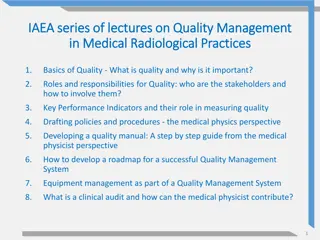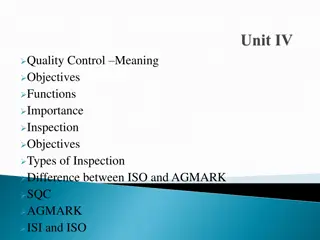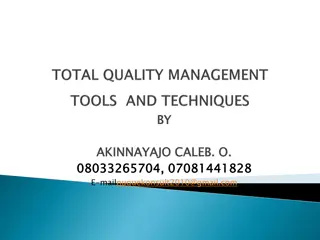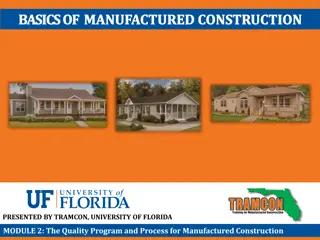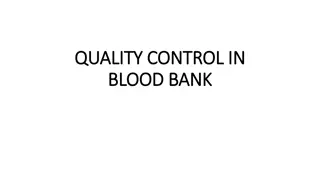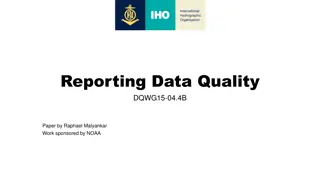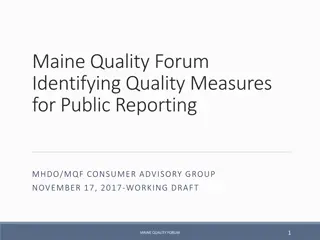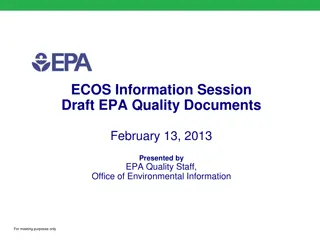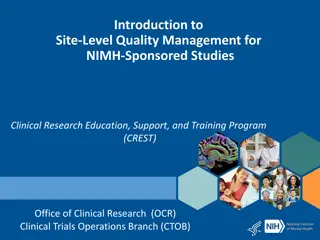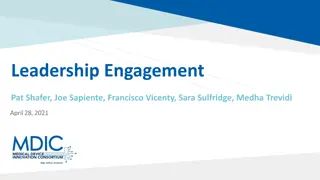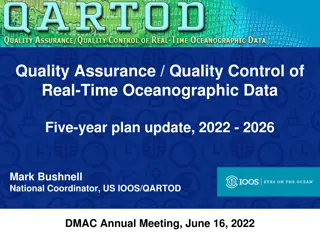Definition and Importance of Service Quality
Service quality is defined as the level of conformity to customer expectations in the delivery of services. Learn about the Gaps Model of Service Quality proposed by Parasuraman, Zeithaml, and Berry in 1985, which examines the gaps that can occur in the service delivery process. Understand the significance of assessing and improving service quality to enhance customer satisfaction and loyalty.
Download Presentation

Please find below an Image/Link to download the presentation.
The content on the website is provided AS IS for your information and personal use only. It may not be sold, licensed, or shared on other websites without obtaining consent from the author.If you encounter any issues during the download, it is possible that the publisher has removed the file from their server.
You are allowed to download the files provided on this website for personal or commercial use, subject to the condition that they are used lawfully. All files are the property of their respective owners.
The content on the website is provided AS IS for your information and personal use only. It may not be sold, licensed, or shared on other websites without obtaining consent from the author.
E N D
Presentation Transcript
Definition of service Berry define service as act, deeds, & performance. AMA define service as activities, benefits or satisfaction that are offered for sale, or provided in connection with the sale of goods.
Performed by.. People, machine, people with machine Service is an activity Deed, Performance Efforts. Rendered by profit, Non profit Service Directed at . people and Business users
What is quality What is quality In the words of crosby:-Quality is conformance to requirements ASQC Define:- Quality is the totality of features and characteristics of a product, or service that bear on it s ability to satisfy stated or implied needs. Fully satisfy customer requirements at the lower cost.
What is service quality? What is service quality? An assessment of how well a delivered service conforms to the client's expectations. Service business operators often assess the service quality provided to their customers in order to improve their service, to quickly identify problems, and to better assess client satisfaction.
What is service quality? What is service quality? Expected Expected service service Service Service quality quality Customer Customer satisfaction satisfaction Customer Customer loyalty loyalty Perceived Perceived service service
GAPS MODEL OF SERVICE QUALITY
The Customer Gap The Customer Gap
The Gaps Model was proposed by A Parasuraman, Valarie Zeithaml and LL Berry in 1985 in the Journal Of Marketing
Professor A. Parasuraman Professor A. Parasuraman
Customer gap: Difference between expectations and perceptions Provider gap 1: Not knowing what customers expect Provider gap 2: Not selecting the right service designs and standards Provider gap 3: Not delivering to service standards Provider gap 4: Not matching performance to promises
Provider Gap 1 Provider Gap 1 CUSTOMER CUSTOMER Expected Service Expected Service GAP 1 GAP 1 Company Perceptions of Consumer Expectations Company Perceptions of Consumer Expectations COMPANY COMPANY
Customers expectations Customer s expectations Reasons for provider gap I Inadequate marketing research orientation Lack of upward communication Insufficient relationship focus Inadequate service recovery Company s perceptions of customer expectations Company s perceptions of customer expectations
Key Factors Leading to Provider Gap 1 Key Factors Leading to Provider Gap 1 Customer Expectations Customer Expectations Inadequate Marketing Research Orientation Insufficient marketing research Research not focused on service quality Inadequate use of market research Lack of Upward Communication Lack of interaction between management and customers Insufficient communication between contact employees and managers Too many layers between contact personnel and top management Insufficient Relationship Focus Lack of market segmentation Focus on transactions rather than relationships Focus on new customers rather than relationship customers GAP 1 Company Perceptions of Customer Expectations Company Perceptions of Customer Expectations
Key Factors Leading to Provider Gap 1 Key Factors Leading to Provider Gap 1
Provider Gap 2 Provider Gap 2 CUSTOMER CUSTOMER COMPANY COMPANY Customer Service Designs and Standards Customer- -Driven Service Designs and Standards Driven GAP 2 GAP 2 Company Perceptions of Consumer Expectations Company Perceptions of Consumer Expectations
Translation of perceptions into service quality specifications Translation of perceptions into service quality specifications Poor service design Reasons for provider gap 2 Absence of customer-defined service standards Inappropriate physical evidence and services cape Management perceptions of customer expectations Management perceptions of customer expectations
Key Factors Leading to Provider Gap 2 Key Factors Leading to Provider Gap 2 Customer Designs and Standards Customer- -Driven Service Designs and Standards Driven Service Poor Service Design Unsystematic new service development process Vague, undefined service designs Absence of Customer-Driven Standards Lack of customer-driven service standards Absence of process management to focus on customer requirements Absence of formal process for setting service quality goals Inappropriate Physical Evidence and Servicescape GAP 2 Management Perceptions of Customer Expectations Management Perceptions of Customer Expectations
Key Factors Leading to Provider Gap 2 Key Factors Leading to Provider Gap 2
Provider Gap 3 Provider Gap 3 CUSTOMER CUSTOMER Service Delivery Service Delivery COMPANY COMPANY GAP 3 GAP 3 Customer Service Designs and Standards Customer- -Driven Service Designs and Standards Driven
Customer designs and standards Customer- -driven service designs and standards driven service Reasons for provider gap 3 Poor human resource policies Failure to match supply and demand Customer not fulfilling their roles Problems with service intermediaries Service delivery Service delivery
Key Factors Leading to Provider Gap 3 Key Factors Leading to Provider Gap 3 Customer Designs and Standards Customer- -Driven Service Designs and Standards Driven Service GAP 3 Deficiencies in Human Resource Policies Ineffective recruitment Role ambiguity and role conflict Poor employee-technology job fit Inappropriate evaluation and compensation systems Lack of empowerment, perceived control and teamwork Failure to Match Supply and Demand Failure to smooth peaks and valleys of demand Inappropriate customer mix Over-reliance on price to smooth demand Customers Not Fulfilling Roles Customers lack knowledge of their roles and responsibilities Customers negatively impact each other Problems with Service Intermediaries Channel conflict over objectives and performance Channel conflict over costs and rewards Difficulty controlling quality and consistency Tension between empowerment and control Service Delivery Service Delivery
Provider Gap 4 Provider Gap 4 CUSTOMER CUSTOMER Service Delivery Service Delivery External Communications to Customers External Communications to Customers COMPANY COMPANY GAP 4 GAP 4
External communications to consumers External communications to consumers Lack of integration of marketing communications Reasons for provider gap 4 Inadequate management of customer expectations Overpromising Inadequate horizontal communications Service delivery Service delivery
Key Factors Leading to Provider Gap 4 Key Factors Leading to Provider Gap 4 Service Delivery Service Delivery Lack of Integrated Services Marketing Communications Tendency to view each external communication as independent Not including interactive marketing in communications plan Absence of strong internal marketing program Ineffective Management of Customer Expectations Not managing customer expectations through all forms of communication Not adequately educating customers Overpromising Overpromising in advertising Overpromising in personal selling Overpromising through physical evidence cues Inadequate Horizontal Communications Insufficient communication between sales and operations Insufficient communication between advertising and operations Differences in policies and procedures across branches or units GAP 4 External Communications to Customers External Communications to Customers
The Services Marketing Triangle The Services Marketing Triangle Company (Management) Internal Marketing External Marketing enabling the promise setting the promise Employees Customers Interactive Marketing delivering the promise
Gaps Model of Service Quality Gaps Model of Service Quality Expected Service Expected Service CUSTOMER CUSTOMER Customer Gap Customer Gap Perceived Service Perceived Service External Communications to Customers External Communications to Customers COMPANY COMPANY Service Delivery Service Delivery Gap 4 Gap 4 Gap 1 Gap 1 Gap 3 Gap 3 Customer- -Driven Service Designs and Standards Customer Designs and Standards Driven Service Gap 2 Gap 2 Company Perceptions of Consumer Expectations Company Perceptions of Consumer Expectations
Gap 1: Learn what customers expect Gap 2: Establish the right service quality standards Gap 3: Ensure that service performance meets standards Gap 4: Ensure that delivery matches promises
listen to customers Use research, complaint analysis, customer panels Increase direct interactions between managers and customers Improve upward communications Act on information and insights
Top management commitment to providing service quality Set, communicate, and reinforce customer-oriented service standards Establish challenging and realistic service quality goals Train managers to be service quality leaders Be receptive to new ways to deliver service quality Standardise repetitive tasks
Service Quality Awards Service Quality Awards Prioritise tasks Gain employee acceptance of goals and priorities Measure performance of service standards and provide regular feedback Reward managers and employees for achievement of quality goals
Can I take your order? Attract the best employees Select the right employees Develop and support employees train employees provide appropriate technology & equipment encourage and build teamwork empower employees internal marketing
You are a Star Service Provider Retain good employees measure and reward service quality achievements develop equitable and simple reward systems
Seek input from operations personnel on what can be done Reality advertising real employees, real customers, real situations Seek input from employees on advertising Gain communications between sales, operations and customers Internal marketing programs
Ensure consistent standards in multi-site operations In advertising, focus on service characteristics that are important to customers Manage customer s expectations What are realistic expectations? Explain industry realities Tiered service options Offer different levels of service - user pays Why do we always have to wait?
Brief Brief Summary Summary Gaps in Service Quality Gaps in Service Quality Gap Problem Cause(s) 1. Consumer expectation mgmt. perception The service features offered don t meet customer needs Lack of marketing research; inadequate upward communication; too many levels between contact personnel and management 2. Management perception service quality specification The service specifications defined do not meet management s perceptions of customer expectations Resource constraints; management indifference; poor service design 3. Service quality specification service delivery Specifications for service meet customer needs but service delivery is not consistent with those specifications The service does not meet customer expectations, which have been influenced by external communication Employee performance is not standardized; customer perceptions are not uniform 4. Service delivery external communication Marketing message is not consistent with actual service offering; promising more than can be delivered


